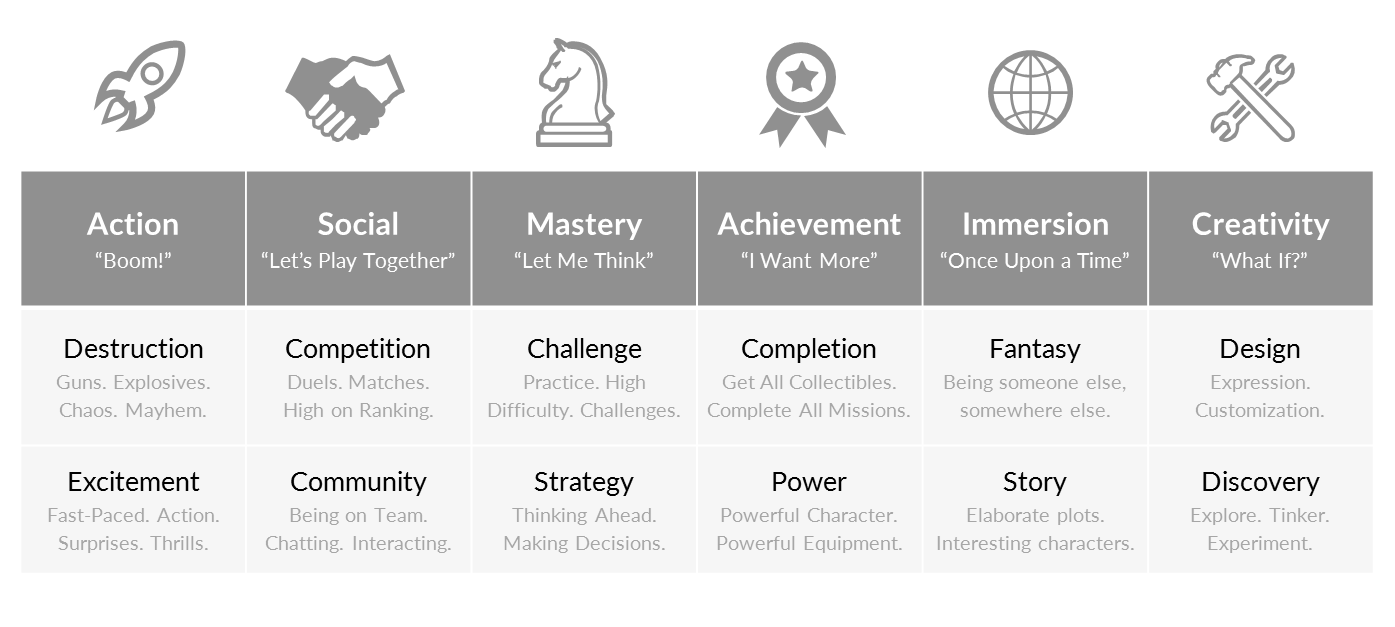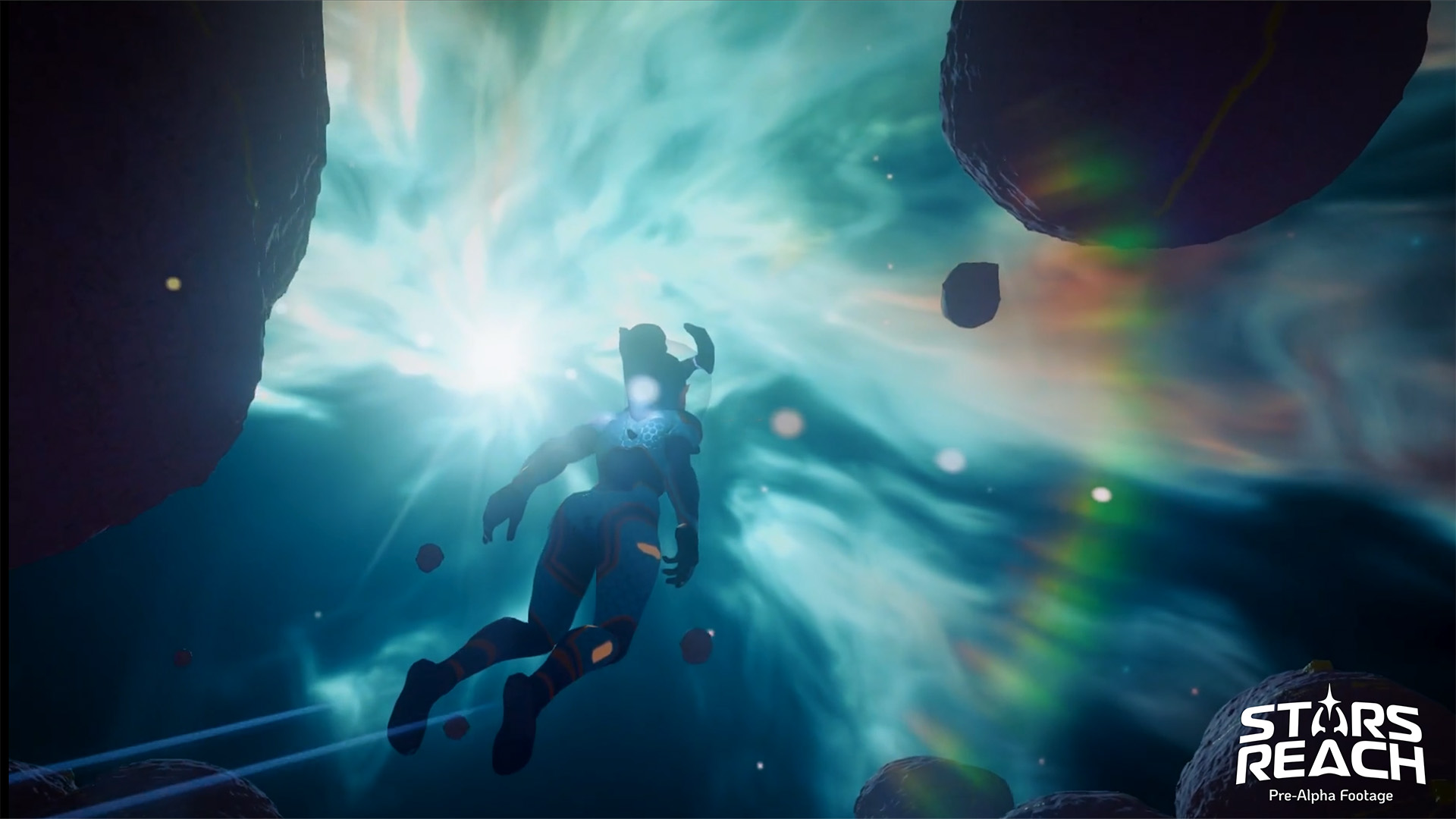By Raph Koster
I think this may actually be the last of the posts outlining the high level goals of the game! And just in time too, because the very first Reachers are going to be landing on a planet in Stars Reach this weekend. That’s right, it’s time to start testing! If you’re interested, be sure to go sign up, and join the Discord and wishlist on Steam while you’re at it.
This is a sandbox game
As you have maybe read from the other articles in the series, SR is very much a sandbox. That means that it is about living in another world, not just chasing XP pellets to complete gear sets. There is no single goal that a player can pursue, except perhaps to work together with other players to try to solve the large scale thematic problem the game presents.
In many ways, then, SR is more about play than it is about advancement. Advancement runs out or becomes an infinite treadmill; whereas if you get bored of playing one way, you can go play in another way and keep having fun.
This means that there isn’t any one journey through Stars Reach. Instead, players choose their journeys. So how do we pick what features we will have?
In themepark games, you build one feature – player-vs-environment combat, usually – to a huge degree of depth, with a ton of progression and advancement in it. You then spare a thought for everything else, because progression is what holds the player.
Back in the day, we used to speak of “elder games,” which meant features and subsystems that were not dependent on content treadmills: stuff like economic play, social play, PvP, and so on, which were much more about interaction with others.
Today, with themeparks having dominated the landscape, we instead speak of “endgame.” Levelling up – the journey – has come to be thought of as the obstacle in the way to getting to “the real game,” which is increasingly group raid coordination.
“End” isn’t really a word you want sitting next to “world” though. Raids are another form of content treadmill, just they call for groups. There are gear sets and color coded items and all the same jazz that there is around the basic levelling game. Very much more about advancement than just play.
Some things to do
So what are some ways we want you to play? Well, here’s a list from our early design documents:
- THE ADVENTURER
- Run across the geyser fields towards a crashed Old One ship, before the Cornucopia get there.
- THE TRANSLATOR
- Observe aliens speaking in strange glyphs; match them up, and crack the code of what they are saying.
- THE EXPLORER
- “Beep! Beep!” Audio signals help you find a soft spot in space to open a new wormhole.
- THE FARMER
- Plant red wheat under a violet sky; crossbreed strains to get a valuable healing variant.
- THE MEDIC
- One press of a button conjures a healing bubble around you as you call your party closer.
- THE XENOBIOLOGIST
- Sneak up on house-sized carnivorous bunnies and draw their blood; gotta sample ‘em all.
- THE PILOT
- Collect crystals fallen from shattered asteroids and drag them in bags behind your ship.
- THE MINER
- Tunnel underground – the map is fully destructible. When the gold is gone, it’s GONE.
In a game that is more about play than it is about advancement, we want to embrace the idea of horizontal progression: that you gain more abilities as you skill up, rather than just numbers going up. And these should give you tactical growth and the feeling of finding new ways to play over time.
So we would want a newbie to be able to blast away at space spiders or alien ice worms in an asteroid field. They should be able to explore a lost Old One laboratory hidden within the mountains of a volcanic planet. They should be able to try to tame a feral blunderhog and name it Fred, or take a mission to smuggle radioactive antigravium through a wormhole.
But an advanced player, someone who has been around the block, ought to be able to use their faction powers as a member of the Purity to call in an airstrike on a nest of the Corruption. They should be able to restore a dead world to life by importing creatures and materials from a distant world, or lead their guild to claiming a new planet, and perhaps become that planet’s first governor. Maybe they make it a pirate den, or they build a powerful corporation by supplying the best spaceship engines in the Galaxy.
Getting practical about development time
Now, you might be thinking that sounds great, but also like we will ship in 2047. And some of that is because we are all so used to themepark progression. If you are designing a sandbox with many features, none of them have all the content progression treadmill that a themepark game devotes to PvE. Instead each one of those systems is small, in terms of implementation. Instead, we rely on the dynamics of the individual feature, and how it connects to other features, to provide the depth.
An example is that alien languages feature mentioned above. It’s basically a codebreaking minigame. All our creatures “speak” their internal AI state over their heads, a lot like the Sims speak Simlish. But it’s all encrypted, and it’s encrypted differently on different planets.
It ties into the collection minigame (you have to collect the glyphs before you can assemble enough to crack the code). And it ties into the economy – once you crack the code, it generates economic value, because you can sell a translator module to a player who doesn’t want to play this way but does want to know whether a creature is about to attack.
But the feature itself is just picking an encryption method. It’s not that different from using code to generate Sudoku boards. If the core puzzle is solid, like Sudoku is, then there’s going to be demand for lots of boards. If they have to be handcrafted, you’re back on the content treadmill.
We strive for every feature to have these qualities: simple elegant rules, deep dynamics, and interconnection to other systems.
Picking which features to make
Even then, though, we can’t make them all. We have our razors to help us cut our own ideas: what the game is about, what the vision items are. But we also have to think about it in terms of who will be playing.
We did a bunch of research to dig into what the demographics were for MMOs of various sorts – high fantasy ones, sci fi ones, games like Minecraft and Fortnite and many others. We looked at what ages the players tended to be. We needed to prove to ourselves that there was a market for the game we were contemplating. And we needed to understand why people chose to play those games.
We’ve worked with two different systems for that over the years. One of them, which we will be asking all our testers to use, is Solsten’s. But when we started out, we used the Quantic Foundry model to think about what drives players.

When we looked across these motivations and examined which ones were most common across ages and genders, some commonalities and differences popped up pretty quickly:
- “Completion” – meaning, collecting stuff and completing sets and task lists – is pretty much in everyone’s top five.
- “Destruction” skews younger, and also male.
- “Fantasy,” the motivation driven by immersion, is universally popular.
- “Story” doesn’t pop as high as you would expect!
After some debate, we decided that for our game, we would treat these things as the core of our unique appeal:
- Community: The enjoyment of interacting and collaborating with other players.
- Fantasy: The desire to become someone else, somewhere else.
- Completion: The desire to complete every mission, get every collectible, and discover hidden things.
- Discovery: The desire to explore, tinker, and experiment with the game world.
- Design: The appeal of expression and deep customization.
And we decided that these items were not core. That doesn’t mean we ignore them or have no features for these motivations, but it helps us define what we are not:
- Challenge: we are not Dark Souls. We want players to feel challenged, but we don’t want to center the game on being the hardest experience ever.
- Story: we are not Uncharted. We want players to feel immersed, but we aren’t going to have them sit back while we tell them a story.
- Power: we are not a game that someone wins and dominates everyone else, like say League of Legends. In fact, we are going to have a bunch of mechanics that cap people’s power, in the name of serving community.
We then went through every feature we wanted to have in the game, and looked at which motivations they could serve. And we invented features and cut features until we had more things in the columns for the elements that are core, and fewer in the columns for the motivations that are not core.
Testing assumptions
After all that, we made game for a few years. And relatively recently, we were able to go back and test again, to see if what we’ve made is getting close to that target, which has evolved as the market has. We put together descriptions of what the game has evolved into, and asked possible players to respond to what they heard.
We told them we were making a shared multiplayer world with many planets but a single universe. A world where you can play any role and learn any skills, with no class limitations. Where you can explore new planets, harvest resources, trade, craft, fight aliens, collaborate with others and transform for the worlds themselves.
We told them you could craft thousands of items both useful and decorative, and that someday you might get so good at it that visitors might come from far away to buy items with your brand on them.
That you would trade across the galaxy in a player-driven economy, where goods have varying prices in different locations. Buy low, sell high, smuggle or own a shop.
Sculpt the worlds, terraforming them and replanting, rerouting rivers and shaping them to the needs of you and your friends. Planets where every substance has unique properties, and creatures have needs and desires. A sophisticated ecological simulation where forests can catch fire and lakes can freeze over, and more.
Active combat with dodging and blocking and situational awareness, with an arcade style but also with options for people who have bad aim or no aim at all. And which players of different skill levels can still play together.
A social world where you can earn XP from helping each other or helping players. Where you can become a leader like the mayor of a town or governor of a planet, but can also play solo and only return to town when you need to buy and sell.
And we asked them to imagine exploring these worlds, traveling through wormholes to discover planets with unknown flora and fauna, unknown resources, and unknown mysteries.
What we got back was a lot of interest. In fact, exploring those living worlds scored through the roof! We also got back worries about griefing, about whether there would be a clear sense of which goals to pursue, and whether the game might be too grindy.
Most importantly, we found that there absolutely was a market for the game we are making. In fact, there’s quite a big market.
We make decisions every day on how deep or detailed to make a feature, or whether we can afford to build it at all. There are plenty of cool ideas we have had which are pushed off to post-launch. We have to be realistic about what we can make.
But it feels great to know that you are making something that not just you feel excited about, but that there’s a lot of other people who will be excited once they hear of it.
And that’s why this weekend is so exciting too. Oh, those poor first Reachers will barely get to see anything! We expect to just crash the client over and over.
But with any luck, we will post a group selfie screenshot of the first strangers to join us on the limitless frontier of Stars Reach.


